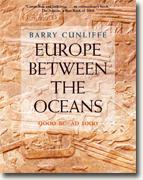Europe Between the Oceans
Barry Cunliffe
book reviews:
· general fiction
· chick lit/romance
· sci-fi/fantasy
· graphic novels
· nonfiction
· audio books
· author interviews
· children's books @
curledupkids.com
· DVD reviews @
curledupdvd.com
newsletter
win books
buy online
links
home
for authors
& publishers
for reviewers

 |
Europe Between the Oceans: 9000 BC-AD 1000 Barry Cunliffe Yale University Press Hardcover 480 pages September 2008 |
|
There's something about "ancient" history that gives me goosebumps. I don't know whether it's the unavailability of many written texts so that the history has to come from archeological evidence or if it's trying to imagine how people lived back in a day where the discovery of bronze-making was remarkable. When I stumbled upon Barry Cunliffe's Europe Between the Oceans: 9000 BC-AD 1000
Europe Between the Oceans Cunliffe uses the whole book to flesh out this fascinating concept. While he does deliver some of the short-term history once into the first millennium BC and civilizations begin forming in the Mediterranean, he concentrates on the medium-term: the movements of the various German tribes; the Huns and other Asiatic tribes storming across Europe; the trade between the various empires and the northern Europeans. Before the first European civilizations forms in Cunliffe’s timeline, he talks about the Neolithic societies that were forming in various areas all over Europe and how they appear to have found each other enough to trade with them, tracking the movement of various commodities that demonstrate these trade routes. Cunliffe is not above speculating how things might have went, but he's always clear when it is speculation and allows for the fact that he could very well be wrong. Cunliffe introduces a concept striking in its simplicity that challenges readers to completely change their world view and open their minds to new thoughts on history. Imagine turning the map of Europe and Asia 90 degrees. Suddenly Europe becomes a peninsula emerging from the vastness of the Asian continent. On this peninsula, the movements of peoples migrating from the vast landmass toward the various coasts (either north or south) of this peninsula become even more interesting. It really does change your perspective on things, especially as the history of Europe becomes not only the migration of peoples around the peninsula but a tale of mass migration from those who found themselves squeezed out of the huge continent that is Asia. Europe Between the Oceans Standard for textbooks, there are no notes, and the "further reading" section at the end doubles as a bibliography. Cunliffe only rarely cites a specific source for any particular piece of information which adds to the textbook feel, since most of these items are included at the end in one big section. The "Further Readings" section brims with detail on various sources for the ideas Cunliffe uses in the chapters. It is divided by chapter, so one gets a real sense of the huge quantities of material that Cunliffe had to absorb for each one. This section could almost be read as part of the book, because Cunliffe really goes into detail on the concepts that he addresses and the literature from which readers can actually draw more information. It's not just a list of sources but interesting in its own right. When you open Europe Between the Oceans Originally published on Curled Up With A Good Book at www.curledup.com. © Dave Roy, 2009 |
|
|
|
 Click here to learn more about this month's sponsor! |
|
| fiction · sf/f · comic books · nonfiction · audio newsletter · free book contest · buy books online review index · links · · authors & publishers reviewers |
|
| site by ELBO Computing Resources, Inc. | |
 While it’s definitely an interesting read, you won’t be carting this volume around with you on your travels on the off chance that you'll get a spare moment here and there to crack open the book and read a couple of pages. Whether or not this was intended to be a textbook, that's basically what it is - and it has the size and heft to match that impression. It is one heavy tome, so much so that I had to take another book if I was going anywhere. This is a stay-at-home book, which isn't necessarily a bad thing.
While it’s definitely an interesting read, you won’t be carting this volume around with you on your travels on the off chance that you'll get a spare moment here and there to crack open the book and read a couple of pages. Whether or not this was intended to be a textbook, that's basically what it is - and it has the size and heft to match that impression. It is one heavy tome, so much so that I had to take another book if I was going anywhere. This is a stay-at-home book, which isn't necessarily a bad thing.